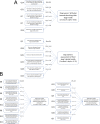Development and validation of two questionnaires: Dental home care and dental health in Swedish dogs
- PMID: 30682017
- PMCID: PMC6347148
- DOI: 10.1371/journal.pone.0204581
Development and validation of two questionnaires: Dental home care and dental health in Swedish dogs
Abstract
Background: Dental disease is one of the most common health problems in dogs. However, no studies have investigated the attitudes, opinions and practices of dog owners, veterinarians and veterinary nurses regarding dental health and preventative dental home care in dogs. The objective of this study was therefore to develop and validate questionnaires for this purpose, in accordance with survey methodology guidelines.
Methods: Questionnaire items were determined based on the authors' academic knowledge and clinical experience, and modified throughout the validation process. Several measures were taken to reduce sampling, coverage, measurement and non-response errors. Content validity was assessed by Subject-Matter Experts (SME) and cognitive interviews were conducted in accordance with the "think-aloud protocol". Non-response analysis was performed using several methods.
Results: Constructs were identified using exploratory factor analysis and two predefined constructs from the dog owner questionnaire were confirmed "Dog owners' attitudes towards brushing their dog's teeth" (Cronbach's α = 0.86) and "Dog owners' assessment of their dog's dental health" (α = 0.76). Additionally, exploratory factor analysis identified three potential constructs. In the veterinary health practitioner questionnaire, two constructs were identified: "Veterinary health practitioners' attitudes towards dental chews and dental feed" (α = 0.78) and "Veterinary health practitioners' attitudes and opinions on dental problems and dental cleaning" (α = 0.73). Non-response analysis showed a higher proportion of women in the sample of dog owners and veterinarians compared to the target populations. Veterinarians in the sample were also younger. In contrast, gender and age distributions in veterinary nurses did not differ between sample and target.
Conclusion: The validation presented in this work showed that the developed questionnaires could be used as accurate and reliable tools for measuring attitudes and practices regarding dental home care in dogs among Swedish dog owners, veterinarians and veterinary nurses.
Conflict of interest statement
The authors have declared that no competing interests exist.
Figures



Similar articles
-
Dental home care in dogs - a questionnaire study among Swedish dog owners, veterinarians and veterinary nurses.BMC Vet Res. 2020 Mar 18;16(1):90. doi: 10.1186/s12917-020-02281-y. BMC Vet Res. 2020. PMID: 32188446 Free PMC article.
-
Professional dental cleaning in dogs: clinical routines among Swedish veterinarians and veterinary nurses.Acta Vet Scand. 2020 Nov 11;62(1):61. doi: 10.1186/s13028-020-00559-7. Acta Vet Scand. 2020. PMID: 33176852 Free PMC article.
-
Dog Owners' Perspectives on Canine Dental Health-A Questionnaire Study in Sweden.Front Vet Sci. 2020 Jun 9;7:298. doi: 10.3389/fvets.2020.00298. eCollection 2020. Front Vet Sci. 2020. PMID: 32582779 Free PMC article.
-
Scope of the Problem and Perception by Owners and Veterinarians.Vet Clin North Am Small Anim Pract. 2016 Sep;46(5):761-72. doi: 10.1016/j.cvsm.2016.04.001. Epub 2016 Jun 2. Vet Clin North Am Small Anim Pract. 2016. PMID: 27264053 Review.
-
Culturally Responsive Care in Veterinary Medicine.Vet Clin North Am Small Anim Pract. 2024 Nov;54(6):889-910. doi: 10.1016/j.cvsm.2024.08.001. Vet Clin North Am Small Anim Pract. 2024. PMID: 39415397 Review.
Cited by
-
Adherence to dental home care in dogs with periodontitis: a post-treatment survey.Acta Vet Scand. 2023 Dec 19;65(1):59. doi: 10.1186/s13028-023-00718-6. Acta Vet Scand. 2023. PMID: 38115050 Free PMC article.
-
Can a multicomponent multidisciplinary implementation package change physicians' and nurses' perceptions and practices regarding thrombolysis for acute ischemic stroke? An exploratory analysis of a cluster-randomized trial.Implement Sci. 2019 Nov 27;14(1):98. doi: 10.1186/s13012-019-0940-0. Implement Sci. 2019. PMID: 31771599 Free PMC article. Clinical Trial.
-
Dog Owners' Ideas and Strategies Regarding Dental Health in Their Dogs-Thematic Analysis of Free Text Survey Responses.Front Vet Sci. 2022 May 3;9:878162. doi: 10.3389/fvets.2022.878162. eCollection 2022. Front Vet Sci. 2022. PMID: 35591871 Free PMC article.
-
Prevalence and factors associated with overweight and obesity in cats in veterinary hospitals in France during the COVID-19 pandemic.J Feline Med Surg. 2025 Feb;27(2):1098612X241305924. doi: 10.1177/1098612X241305924. J Feline Med Surg. 2025. PMID: 39916303 Free PMC article.
-
Pet Ownership in Aotearoa New Zealand: A National Survey of Cat and Dog Owner Practices.Animals (Basel). 2023 Feb 11;13(4):631. doi: 10.3390/ani13040631. Animals (Basel). 2023. PMID: 36830418 Free PMC article.
References
-
- Niemiec B. Veterinary periodontology: John Wiley & Sons; 2012.
-
- Hamp SE, Olsson SE, Farsomadsen K, Viklands P, Fornell J. A Macroscopic and Radiologic Investigation of Dental Diseases of the Dog. Veterinary Radiology. 1984;25(2):86–92. WOS:A1984SM55800005.
-
- Wiggs RB, Lobprise HB. Veterinary dentistry: principles and practice. Philadelphia: Philadelphia: Lippincott-Raven Publishers; 1997.
-
- Fernandes NA, Borges APB, Reis ECC, Sepúlveda RV, Pontes KCdS. Prevalence of periodontal disease in dogs and owners' level of awareness—a prospective clinical trial. Revista Ceres. 2012;59:446–51.
Publication types
MeSH terms
LinkOut - more resources
Full Text Sources
Medical

